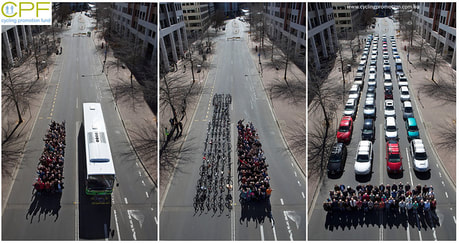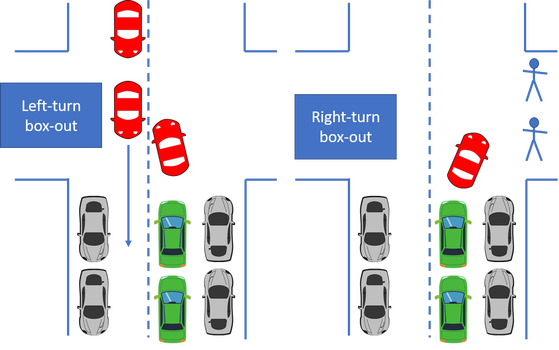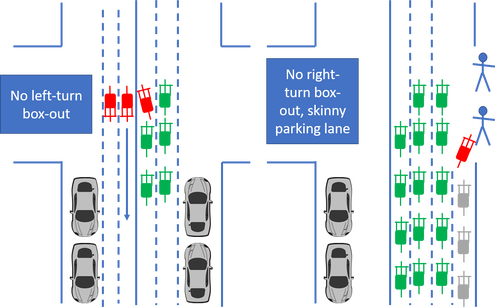|
City driving is awful, we’re failing at our emissions and vision zero goals, and outside of more working from home, we have not made much progress on these fronts. Fortunately, these issues are all fixable with small vehicles like e-bikes, scooters, and microcars, as well as a few thousand gallons of paint. Embracing the micromobility revolution will eliminate gridlock, reduce emissions, clear the air, and lower taxes. Where we are today Driving in the city sucks. Highways in major US cities are packed, so you’re often stuck in stop-and-go traffic averaging 20 MPH. On city streets it gets even worse: whenever you’re in a single-lane line of cars 5 deep at a red light, you’ve got a good chance that at least one of them will do a stoplight space out, box everyone out as they attempt to make a left, or box everyone out while waiting for pedestrians to mosey across the intersection when they want to go right. Any of these situations will likely cause you to miss a phase, so you’re stuck waiting for another minute, and your average speed declines. These bottlenecks are a large part of the reason it takes forever to get anywhere in a city by car. When you get close to your destination, you then have the joy of circling the block 5 times to find a parking spot, and your inner monologue goes like this: “Is that a… oh no, fire hydrant, dammit. How about right there behind the… nope, 30-minute delivery slot. Ok, let’s go down this street here. ‘No parking within 30 feet??’ Dammit. ‘Street cleaning Tuesdays.’ Today’s…wait, oh dammit, Tuesday.” You continue this game for maybe 10 minutes until you finally find something, then have to backtrack the 5 blocks to get to your destination. By this point, you’re late, frazzled, and your meeting doesn’t go well. These are but a few examples of the frustrations of city driving. In many cities, car traffic moves below 10 MPH. In New York City, it’s around 5 MPH. Commuters in many cities spend countless hours a year sitting in traffic. The bottom line is that cars in dense and congested cities are a slow way to get from A to B. It doesn’t need to be this way. The basic problem: packaging efficiency  You ever order something online like a USB stick, only to have a shoe box-sized package show up with a bajillion packing peanuts and then a little baggie with the USB stick in it? For urban transportation of 1-2 people, cars are the proverbial shoe box for a USB stick: they’re a much larger container than is needed for the payload and mission. This photo illustrates the problem well, with 60 people alternately in cars, a bus, and on bikes: Why do cars have such bad packaging efficiency? Most cars are overbuilt for urban transportation. They’re designed with ranges of hundreds of miles for speeds in excess of 100 MPH, and with safety equipment to make collisions at higher speeds survivable for their occupants. This makes them great at moving payloads around rural and less-densely populated suburban areas, but too large for cities. For urban use, these capabilities add unnecessary weight, complexity, and thus cost to the finished product. The second reason cars are too big is a range of subsidies for roads and parking that lower the direct costs of car usage while driving up costs elsewhere in the economy. Road subsidies artificially cheapen driving According to the Tax Foundation, the share of road funding across the United States from tolls, fuel taxes, and fees lies between 7% and 73%, with a 53% nationwide average. In other words, about half of road funding is subsidized by money from the general tax base. In my city, Seattle, we’ve got the West Seattle Bridge fix/replacement story, which looks likely to cost around $400 million, likely more by the time all the dust settles. We recently spent $3.3 billion on the SR 99 tunnel, a third of which came from state, federal, or local budgets. Many areas also have requirements for “free” parking, which according to Don Shoup is anything but: someone is still paying to provision the space to store the vehicle, in the form of more expensive products, rents, or spending tax money to store private property on public land. In sum, we’re spending huge amounts of public funds on infrastructure to move and store vehicles that are way larger than they need to be, and even then, the user experience is an awful crawl through gridlock and pollution. We can, and should, do better, by right-sizing vehicles for the mission and adapting roads to meet them. right-sizing Vehicles All good engineering projects start with a clear understanding of the problem. According to Table 6b of the USDOT’s 2017 NHTS, average trips are 10.5 miles all-up, and 12.8 miles for commutes. 76% commute alone, though this rate is lower in many cities. The NHTS puts the total car occupancy for all trips at 1.55 in 2009. Pulling these together gives us a handful of requirements for a commuting vehicle:
As e-bike adoption increases, we’ll need to focus more on right-sizing roads to accommodate the changed blend of vehicles. Right-sizing roads: lane doubling One major adoption hurdle with e-bikes and smaller micromobility vehicles like scooters and powered skateboards in general is safety. Many people I’ve spoken with about cycling or e-biking in cities are nervous about getting hit, and even confident riders avoid certain areas they deem dangerous. I’ve written in the past that city planning employees should use the infrastructure they’re responsible for building and maintaining, which in places where implemented should accelerate the pace at which problems get resolved. One cheap and elegant solution to increase safety as well as to accommodate a growing number of e-bikes is lane doubling: cities should take a 10-foot-wide lane and paint a centerline stripe down it to make two smaller micromobility lanes for the growing number of small vehicles. Such a change will immediately double the throughput by allowing e-bikes to go two-abreast. Bottlenecks, like the frustrating left- and right-turn box outs will now be cleared: Signal phases can be made shorter because each column of vehicles will be shorter by at least half, further increasing average speeds. In streets where there are two travel lanes and two parking lanes for a total of 4x10’, these can be redrawn to 8x5’, with e-bike/micromobility parking on the sides. Shrinking the width of the parking lanes would allow a third travel lane each way, which combined with the flow efficiencies would yield in excess of a 3x improvement in total throughput. Some lanes will still need to remain wider, for buses, trucks, and other vehicles. Overall, lane doubling and intersection enhancements will allow a combination of increased urban densification and lower road spending. Wherever the throughput requirements can be met with narrower roads and bridges, we can spend less on construction and maintenance and in turn avoid many of the costly boondoggles like the SR 99 tunnel, West Seattle Bridge fiasco, and further examples in other cities. The billions saved in Seattle alone can be returned to taxpayers or reinvested in solving other problems like housing affordability. Smaller parking requirements will mean business owners won’t need to spend as much on that space, which will lead to lower prices for goods and services. Less traffic, cleaner air, lower prices, and less tax: let’s sign up for the micromobility revolution. Implementation hurdles There may be a few of you who are not 100% sold on the urban micromobility utopia (shall we call it “umu?” Maybe not, this is why I don’t get invited to Marketing meetings…). As I’ve developed this idea, I’ve encountered a few objections that I’ve listed below, and several of you will come up with more. When formulating the objections, please consider the following question: “Does the cost of addressing [objection] make the entire idea bad on net, or is it a solvable problem that will eat up a small fraction of the billions in savings?”
0 Comments
Originally published on February 8th, 2020
Dear airlines, please sell us sustainable aviation fuels (SAF). It’s the only feasible way to green up aviation at the moment.* I’ve cleaned up most of my CO2-emitting activities, but now flying remains as the largest remaining slice of the pie. I have a family that is spread out over multiple continents and travel a decent amount for work, which usually involves flying. I’m not the only one in this situation: several others have simply decided to stop flying or shame those who do. I’m a strong believer that aviation is good for modern society: about a third of global trade by value is transported by air, and traveling to other places makes us more open and creative. As Mark Twain famously stated, “Travel is fatal to prejudice, bigotry, and narrow-mindedness.” With that said, I’d like to work with you to make aviation a better global citizen as we move into the next decade. How should airlines address this? What I’d like all of you to do is add an option in your booking flow to “fly my seat with sustainable fuel.” You’re clearly experts at upselling exit rows, early boarding, bags, and other things, so I know that building the web experience should be trivially simple for you. From a pricing standpoint, you can compute the marginal cost differential between SAF and fossil jet based on the route, the aircraft assigned, and historical fuel burn to spit out a number. Then we, the consumers, can simply select the option and be on our way. Microsoft has pledged to remove its historical CO2 and go CO2-neutral by 2030, so selling them the option should be a slam-dunk (Delta and Alaska, I’m looking at your corporate contract teams right now) (Edit: looks like KLM has part of the pie). More will surely follow. Some of you have already gotten started in the space, but if I didn’t proactively search for these resources, I wouldn’t find them. If the emergence of flygskam in 2019 is an indicator for the future, then you need to start skating to where the puck’s going by adding the SAF booking option for us. That cash flow will boost SAF investment to accelerate the closing of the cost gap to fossil jet. The IPCC tells us that we’ve got 10 years, so get to work. *Why is SAF currently the only real option? Right now, commercial aviation represents roughly 2% of global CO2 output, and that fraction is climbing. Aircraft efficiency has improved in leaps and bounds during the jet age and continues to improve about 10–15% with every new generation of airliners. These improvements in efficiency make it so much cheaper for people to fly that we are seeing overall passenger numbers climbing at 5% per annum while total emissions are climbing at 3%. By 2050, emissions are expected to be at triple their current amount. What we need is not just to reduce unit emissions (efficiency), but total emissions as well, and quickly. Global agreements to limit emissions have not gone well, as evidenced by the squabbling over the ETS and the fizzled COP 25 summit. Most people think their governments are dysfunctional, so those waiting for a few hundred of those to cooperate must have a lifetime supply of popcorn. What can be done to reduce emissions? Several ideas have been proposed over the years to address aviation’s growing CO2 emissions. Pioneers in electric propulsion like Harbour Air have flown an e-Beaver using a magni-X motor, which will help improve air quality, reduce noise, and reduce maintenance costs. The problem with electric propulsion remains energy density: lithium-ion batteries have 2% the energy per unit weight as jet fuel. Factoring in better powertrain efficiency gets us closer to 7%. I’m excited to see the batteries improve, but it will likely be decades until a battery-powered plane can cross oceans with a useful payload at a reasonable cost. For longer distances, hydrocarbons are presently the only realistic energy source that can keep planes in the air. CO2 offsets have been proposed as a solution, but many of them have their own problems: dig up fossil fuels from long-term storage, introduce it to the short-term carbon cycle by flying, and pay someone to plant a few trees to offset that. Seems great, but how can anyone be sure that those trees don’t get chopped down for firewood in a decade? This leaves us with SAF as our only realistic option. Broadly speaking, SAF includes synthetic fuels made from renewable energy and second-generation biofuels that don’t compete with food production like first-gen biofuels. SAF, due to its production process, usually consist of fewer molecule types and fewer impurities than fossil jet, which results in cleaner combustion, 50–70% fewer particulates, and in turn fewer heat-trapping contrails. Why are we not flying with 100% SAF yet? Two reasons: fuel composition requirements and cost. The fuel specification for Jet-A, ATSM D-7566, currently requires 50% petroleum-derived fuels to ensure sufficient aromatics in the blend to preserve engine seals. Many forms of SAF don’t have sufficient aromatic compounds, which can cause seal shrinkage. Some companies, like Byogy, have addressed the problem of the aromatics content, so the specification could be amended once adequate experience shows that the fuels perform similarly. Regarding the economics, SAF is currently more expensive than fossil jet fuel for a few reasons:
|
AuthorMerlin is a pilot, cyclist, environmentalist, and product manager. Archives
June 2021
Categories |


 RSS Feed
RSS Feed